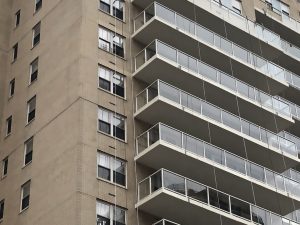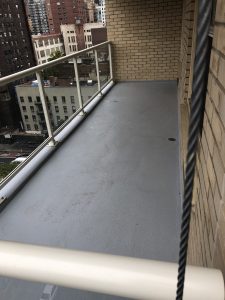
Balconies are a tremendous amenity in New York City (NYC); however, many building owners and city officials know that a balcony is a major maintenance item that requires regular inspections. Due to the constant exposure, balconies are subject to the weather elements, especially harsh winter conditions in the northeast. Concrete balconies are under threat of freeze/thaw cycles, precipitation, and saltwater exposure from nearby bodies of water. Balconies are also subject to other common issues, such as overloading of the structure, long-term creep, improper construction/design, failed or missing waterproofing, and construction with dissimilar and often incompatible materials.
Most people who are familiar with the northeast and NYC area are aware of the severe and abrupt changes in weather. Temperature ranges can fluctuate from sub-zero to 100°F and beyond. The constant presence of salt in the air from nearby bodies of water, exposure to regular freeze/thaw cycles, wind-driven rain, and pollution all impact the overall lifespan of a balcony. Long-term exposure to the elements will break down a protective waterproofing membrane and allow for moisture infiltration. After moisture enters the slab, freeze/thaw cycles will cause the formation of cracks in the concrete. The onset of moisture within the slab will lead to carbonation of the reinforcing steel which will corrode, then expand, and then cause spalls in the concrete.
If no remediation is performed to correct and prevent the ongoing corrosion of the steel, significant slab repairs may be necessary for an effort to restore balconies to their desired strength. Replacement of the steel reinforcement or supplemental steel reinforcement may be required through full-depth slab repairs, or in the worst-case scenario, complete balcony replacement.
Balconies are designed to accommodate a specific amount of static loading, such as dead and live loads. The dead load of the structure includes the weight of the concrete slab, railings, and any other materials permanently fixed to the substrate, such as pavers and tile systems. Live loads consist of any temporary or transient forces that act on a building or structural element; this includes people, furniture, and any items not permanently fixed.
Designated live load design values for balconies were first introduced in the 1968 NYC Building Code and specified that balconies are designed to withstand a live load 1.5 times that of the adjoining adjacent space, but not to exceed 100 pounds per square foot. For average residential buildings constructed after 1968, this generally means a live load design of 60 pounds per square foot.
During the course of our inspections, we often find that buildings allow their residents to put anything on their outdoor spaces. We have seen items such as large planters, flowerpots, tile and/or wood deck overlays, storage closets, barbeque grills (which are illegal to be on balconies in NYC), and patio furniture. Over time, the additional load of these items contributes to the long-term deflection or displacement due to the load upon the structure. This displacement will eventually become notable to the naked eye and the structural movement can commonly lead to water drainage issues and the formation of cracks in the concrete.
Improper design and construction commonly lead to ongoing issues with concrete balconies in NYC today. An improper design could include the wrong sizing or placement of the steel reinforcing bars or steel mesh embedded within the slab. Inadequate waterproofing, undersized drains, and insufficient pitch on top of the slab for positive water drainage are all deficiencies that are frequently observed on balcony structures.
One of the most common issues with concrete construction is the lack of proper concrete cover and embedment provided for the steel reinforcement members of the balconies. Building code establishes that the required clear coverage is needed for the size of the bars but, in many cases, the proper coverage is not maintained during the construction of the slab. Reinforcing bars may shift during the concrete placement if they are not properly secured during construction.

It is very common to see concrete balconies without a protective waterproofing membrane on older buildings. Waterproofing membranes such as pedestrian traffic coating systems, as well as elastomeric systems, are essential for increasing the longevity of the concrete balcony. Coatings and waterproofing membranes mitigate moisture infiltration within the slab and prevent corrosion of the steel reinforcement. These protective exterior coating systems can bridge minor cracks within the slab and accommodate contraction and expansion. However, as great as the waterproofing systems are, they do have a limited lifespan due to UV exposure, environmental degradation, and consistent foot traffic. The aforementioned regular maintenance inspections are crucial to the health of waterproofing systems. Regular maintenance will minimize the extent of damage to the waterproofing membrane due to residential traffic. If furniture or other items are causing wear on the balcony coating, they can damage and reduce the lifespan of the waterproofing system. These types of systems typically have a five- to ten-year warranty. In the event that existing balconies do not have a waterproofing membrane, a qualified building envelope consultant can provide recommendations to maintain balcony integrity.
Another common condition observed on balconies is the use of dissimilar metals and incompatible materials in design. Galvanic corrosion will occur between dissimilar metals such as carbon steel and aluminum, as well as aluminum and concrete. For the intersection of carbon steel and aluminum, when an electrolyte such as water is introduced into the system, the aluminum begins to corrode. Long-term exposure and contact between these metals will lead to localized failures. These types of failures are seen when an aluminum railing is sleeved into a concrete slab and butts up against carbon steel reinforcement. Aluminum reacts with the alkalis in Portland cement in the concrete. This reaction also produces significant corrosion in the aluminum and there is a hydrogen off-gassing effect.
A prudent preventative measure for this failure is ensuring that the aluminum railing post sleeves are coated with epoxy. Proper design and oversight by a qualified engineer/architect can mitigate this risk.
The causes previously mentioned in this article often lead to various conditions such as cracks on the topsides and undersides of the concrete slabs, spalls at the railing supports, loose railings, and cracking/spalling at the balcony fascias. All of these items are regularly identified in the NYC FISP (Façade Inspection Safety Program) investigations (formerly known as Local Law 11). There is endless historical information and new technology available to us today, so it is our duty as engineers, architects, and building owners to ensure that we are performing regular inspections and maintenance, properly designing repairs and waterproofing systems, and budgeting funds for future maintenance and capital repairs.